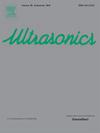穿戴式超声对2型糖尿病小鼠血糖水平的调节
IF 3.8
2区 物理与天体物理
Q1 ACOUSTICS
引用次数: 0
摘要
2型糖尿病(T2DM)是一种慢性代谢性疾病,对人类健康造成了显著的负担。目前需要长期药物和饮食控制的治疗方法经常面临患者依从性的挑战。虽然低强度脉冲超声(LIPUS)在调节血糖方面显示出良好的前景,但传统超声设备由于体积大、成本高,其临床应用仍然具有挑战性。通过理论模拟,我们设计并制作了频率为986 kHz的可穿戴超声贴片及其可穿戴驱动装置,用于db/db小鼠的血糖调节。将db/db小鼠肝脏-胰腺区域置于可穿戴超声装置下,频率为986 kHz,占空比为30%,脉冲重复频率为2 kHz, ISATA为86.81 mW/cm2,持续时间为10 min。结果显示,LIPUS处理的db/db小鼠暴露于LIPUS 8周后,血糖恢复到基线水平的时间延长。葡萄糖耐量改善,胰岛素抵抗降低,体重减轻。肝脏形态维持良好,表明LIPUS对调节db/db小鼠血糖的有效性。生物安全测试表明对组织没有不良影响。本研究表明,使用可穿戴超声设备,通过低强度脉冲超声(LIPUS),可以有效调节db/db小鼠的血糖水平。我们的方法为调节T2DM患者的血糖水平提供了一种无创解决方案,并有望将超声应用于代谢性疾病的治疗。本文章由计算机程序翻译,如有差异,请以英文原文为准。
Wearable ultrasound regulation of blood glucose levels in type 2 diabetic db/db mice
Type 2 diabetes mellitus (T2DM), a chronic metabolic disorder, imposes a notable burden on human health. Current treatments that require long-term medication and dietary control often face challenges with patient compliance. Although low-intensity pulsed ultrasound (LIPUS) shows promise in regulating blood glucose, the clinical application of traditional ultrasound devices remains challenging due to their large size and high cost. Through theoretical simulation, we designed and fabricated a wearable ultrasound patch with a frequency of 986 kHz and its wearable driving device for use in blood glucose regulation in db/db mice. The liver–pancreas region of the db/db mice was exposed to the wearable ultrasound device with the following parameters: frequency at 986 kHz, duty cycle at 30 %, pulse repetition frequency of 2 kHz, ISATA of 86.81 mW/cm2, and 10-min duration. Results showed that LIPUS-treated db/db mice exhibited a prolonged time for blood glucose to return to baseline levels after 8-week LIPUS exposure. Improved glucose tolerance, reduced insulin resistance, and decreased body weight were also observed. Liver morphology was well maintained, demonstrating LIPUS effectiveness in regulating blood glucose in db/db mice. Biological safety tests indicated no adverse effects on the tissues. This study demonstrates that the use of a wearable ultrasound device, through low-intensity pulsed ultrasound (LIPUS), can effectively regulate blood glucose levels in db/db mice. Our approach offers a noninvasive solution for regulating blood glucose levels in patients with T2DM and holds promise for ultrasound application in metabolic disease treatment.
求助全文
通过发布文献求助,成功后即可免费获取论文全文。
去求助
来源期刊

Ultrasonics
医学-核医学
CiteScore
7.60
自引率
19.00%
发文量
186
审稿时长
3.9 months
期刊介绍:
Ultrasonics is the only internationally established journal which covers the entire field of ultrasound research and technology and all its many applications. Ultrasonics contains a variety of sections to keep readers fully informed and up-to-date on the whole spectrum of research and development throughout the world. Ultrasonics publishes papers of exceptional quality and of relevance to both academia and industry. Manuscripts in which ultrasonics is a central issue and not simply an incidental tool or minor issue, are welcomed.
As well as top quality original research papers and review articles by world renowned experts, Ultrasonics also regularly features short communications, a calendar of forthcoming events and special issues dedicated to topical subjects.
 求助内容:
求助内容: 应助结果提醒方式:
应助结果提醒方式:


